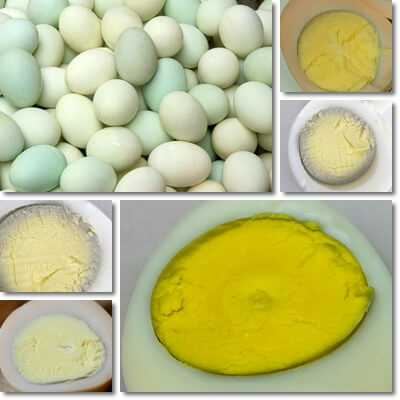Eggs are a staple food and present in most diets in one form or another.
Which is great for health considering their superior nutritional value that contributes measurably to daily values of most essential vitamins and minerals.
But eggs are also one very curious food.
One curious thing about eggs is that the cooked yolk can turn green, olive green to be more exact.
What does it mean when cooked egg yolk turns olive green? Is that dangerous? Is the egg yolk still safe to eat or not? Where does the olive green color come from? Do some eggs have different yolk colors? Is olive green a sign the egg yolk has gone bad?

What color is egg yolk normally?
Raw egg yolk is normally yellow. The exact shade of yellow usually varies between a light, luminous yellow to a deep yellow to an orangey yellow to a reddish orange. The diet of the bird is what will ultimately determine the color of the egg yolk.
Where does egg yolk get its color from?
Egg yolk gets its natural color from organic pigments occurring naturally in the plant foods present in the diet of the bird.
Birds commonly eat foods such as corn, marigold petals, dandelion flowers, red bell peppers and other pepper colors, red tomatoes and yellow yellow tomatoes, red and yellow watermelon, green acorns, alfalfa, grass, lettuce, salad greens and other green plants, all of which are high in natural pigments.
Yellow, orange, red and green pigments from plant foods will get transferred in the yolk of the egg laid by the bird; the same thing happens with foods that color stools such as Oreo cookies that turn stools very dark brown to black.
The more pigmented foods in a bird’s diet, the deeper and richer the color of the raw egg yolk, but only to a certain extent – the normal, natural diet of a bird simply doesn’t make egg yolks blue or purple or green.

When is olive green egg yolk an okay color?
If your eggs are cooked, olive green is an okay color for the egg yolk. It’s actually common to see some degree of olive green on your egg yolk if it’s hard-boiled or baked.
Chicken eggs, duck eggs and also quail eggs and goose eggs and other types of eggs can have an olive green yolk if they’ve been hard-boiled or baked in the oven. And they remain perfectly edible and 100% safe to eat.
Note:
Olive green is not an okay color in raw egg yolk – if your raw egg yolk is olive green or other shades of green, or worse, red, brown or black, make sure it’s not rotten.
Check the expiration date and storage conditions, and check for signs such as cracks in the shell, bad or unusual odors, presence of black, green or white mold or impurities. These are clear indications the egg is no longer safe to eat; consumption at this point is dangerous for health.
What does an olive green egg yolk look like?
The standard look for a hard boiled egg yolk is yellow. But a hard boiled egg yolk can also be olive green, or a grayish olive green to a certain degree.
While it’s unusual for an entire hard boiled egg yolk to be olive green, close to half of it may be. Most commonly only the outside of the boiled yolk is an olive green or grayish olive green.
This is what is referred to as a ‘green ring’ – when the yolk is cut in half, the olive green looks like it circles the yolk like a ring.
It’s also common for the boiled egg white to be tinged with some olive green from the yolk. So if you cut into your hard boiled egg and see an olive green ring around the yolk, don’t worry – the egg is still good to eat.
Baked eggs can also have an olive green or grayish olive green ring around the yolk. The ring of green may be thinner or thicker and can appear in chicken, duck and other types of eggs.
What causes an olive green egg yolk?
The olive green ring that forms in boiled or baked eggs where the egg white and egg yolk meet comes from a chemical reaction between compounds occurring naturally in the two egg components. More specifically, sulfur compounds and iron.
Sulfur compounds from the egg react with the high iron content in the egg yolk during high heat cooking such as boiling and baking and create the ring of olive green around the yolk.
Yes, you’ve read that right: eggs contain sulfur – sulfur is actually where the familiar egg smell comes from. For example, vitamin B1 (thiamine) and vitamin B7 (biotin) from eggs naturally contain sulfur. Amino acids that form the protein in egg, namely cysteine and methionine, also contain sulfur. And the yolk has plenty of iron.
A high iron content in the boiling water and use of iron cookware can also be contributing factors to the reaction that forms the olive green ring around the cooked yolk.
Why do some eggs have an olive green ring and some don’t?
Sulfur compounds from vitamins and amino acids in egg white and egg yolk react with iron from the egg yolk and cause an olive green ring around the yolk. But not all eggs have this green ring. This is because certain factors make it more likely for the ring of color to form around the yolk.
For example, high heat cooking common in hard-boiling and baking, but also long cooking times – it can’t hurt to boil eggs for 10 more minutes past the recommended time, just to make sure they’re done, right?
The use of iron cookware or a high iron content in the cooking water have also been proposed as contributing factors. However, the eggs don’t really need any help to get that olive green ring around the yolk that’s so off-putting for so many people.
To prevent the olive green ring around the yolk, allow your eggs to reach room temperature first and then proceed to boiling them. Boil over medium-low heat for sufficient time, but don’t exceed the recommended number of minutes depending on the size of the egg. Finally, as soon as they’ve finished boiling, stop the cooking process with cold water. You can either drain the hot water from the pan or pot in the sink and pour cold water over the eggs, or simply move the eggs to a bowl of icy cold water.
